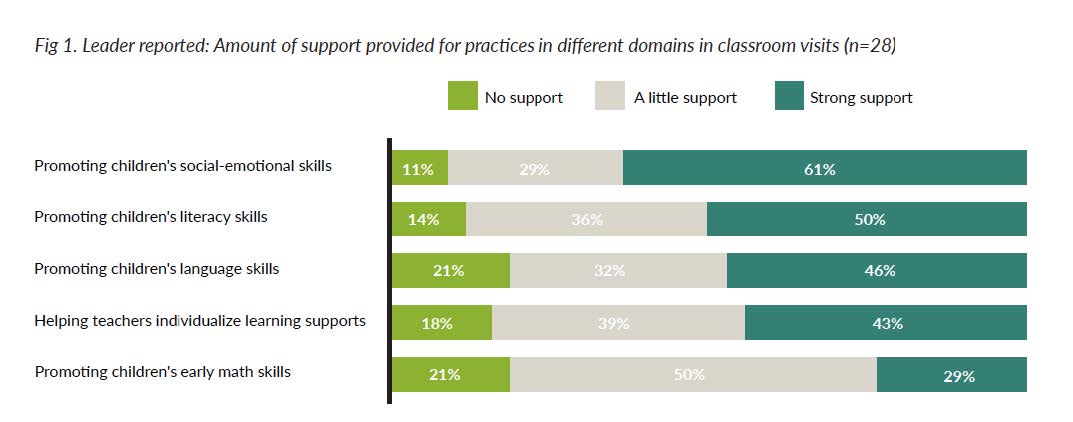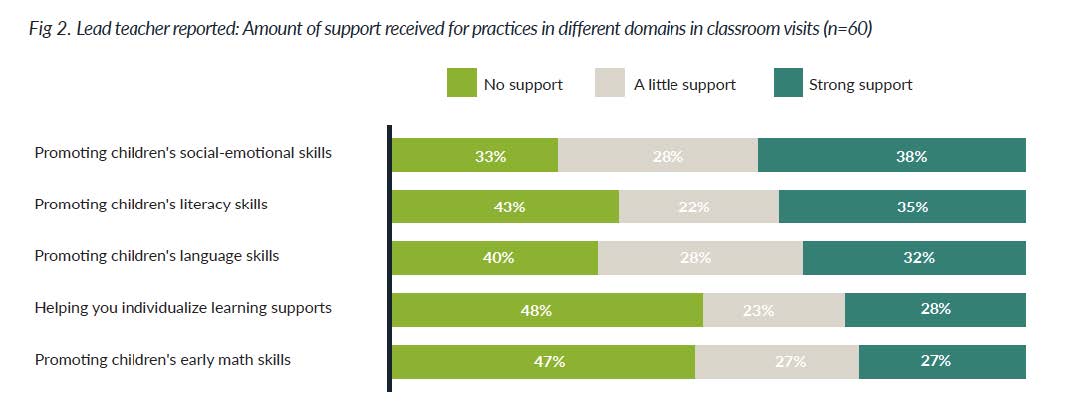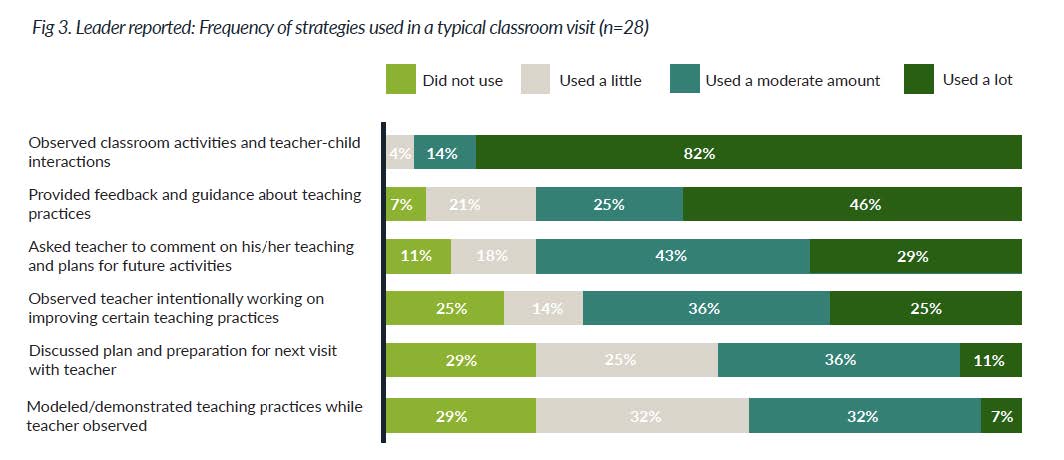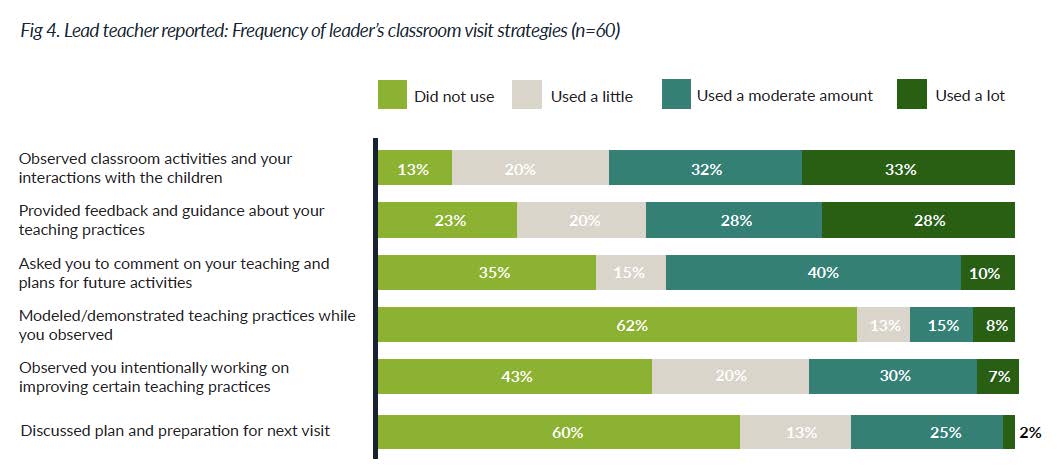A key challenge for the Early Care and Education (ECE) field is identifying key features of program quality that matter for children’s learning and social-emotional outcomes. In recent years, the role of leaders in ECE programs has been recognized as critical to achieving and maintaining effective teaching and other aspects of quality.1 These leaders are often called education directors in community-based ECE programs; in public schools, principals or assistant principals may serve as PreK leaders. In either type of setting, Pre-K leaders can provide a variety of supports to teachers, including guidance about their use of effective practices, coaching, and the facilitation of peer to peer learning and professional development outside of the program. This brief presents key findings from a study of Pre-K leaders in NYC preschool programs. The following questions were addressed:
- How do leaders at diverse sites support teachers’ practices to strengthen program quality?
- What factors help or hinder leaders’ efforts to positively influence learning for all children through teacher support?
In the sections that follow, the brief provides information about the study’s methods, results, and recommendations.
Methods
Pre-K leaders and teachers at 36 preschool sites located across nine community districts and four boroughs were recruited to participate in the study from August, 2016 to November, 2016. The final sample was comprised of 30 professionals in leadership roles: 24 were education directors in community-based sites and 6 were site directors or assistant principals in public school sites. In addition, 70 lead teachers, 52 assistant teachers, and 4 paraprofessionals/aides participated in the study.
The results reported in this brief are based on structured interviews with the 30 leaders and with the 126 teaching staff. The interviews asked leaders closed and some open-ended questions about how they supported teachers during classroom visits and through other activities such as peer-to- peer learning; teachers also answered questions about their backgrounds, knowledge, and their own professional development supports for leadership. While interviews were administered three times over the year with modified versions, most of the findings in this brief are based on Time 1 interviews conducted in October to January.
Results from a time-use survey at Time 1 are also discussed. The time-use survey asked leaders to describe tasks throughout the previous day in sequential order. Coders found it difficult to reliably identify time periods from this survey given the overlap of reported activities, and instead coded events. Results from coding observations of 6 feedback sessions, following a leader’s classroom visit, are also presented. These observations occurred mid-year, and strategies used by the leader were coded by 2 researchers who resolved differences in coding through discussion.
Key Findings
Characteristics of Participants
Ninety percent of the leaders hold a Masters degree, 75% a NY State Teacher Certification, and 53% an Early Childhood Education Teaching Credential. Ninety-seven percent of the leaders have been teachers before, but only 21% have had training to be a supervisor of teachers (i.e., a state-issued supervision certificate). Twenty percent of the leaders speak languages other than English, Spanish, and French.
Seventy-seven percent of teachers had been in their current position for five years or less and 53% had worked in education 10-19 years. Thirty-seven percent of teachers speak Spanish in some capacity.
Leaders’ Support of Teachers’ Effective Practices Through Classroom Visits
Leaders reported on frequency and duration of their visits to classrooms to provide support for effective teaching. They reported on how often they visited classrooms that they judged to need “a lot of support” and classrooms that needed “an average amount of support.”
Most leaders make frequent visits to classrooms needing strong supports, and most report visits that are at least 15 minutes.
- 62% of leaders reported visiting a classroom of a teacher needing a lot of assistance at least once a week.
- 43% of leaders reported visiting a classroom needing an average amount of assistance at least once a week.
- 40% of leaders reported long visits (30-45 minutes or longer).
- 33% reported visits of 15-30 minutes.
- 27% reported brief (5-15 minute) visits.
Leaders reported on the amount of support they provided during classroom visits for teaching practices that promote children’s learning in different domains such as social-emotional and language skills. Teachers reported on the amount of support they receivedfrom leaders for teaching practices that promote children’s learning in the same domains.
Most leaders report strong support for practices that promote social-emotional skills; half or fewer leaders report strong support for other key practices.
As shown in Figure 1, the highest percentage of leaders reported “strong support” for teaching practices that promote children’s social-emotional growth. Less than half the leaders provide “strong support” for practices that promote children’s language growth; “strong support” for practices that promote math skills was reported by the lowest percentage of leaders.

Compared to leaders, fewer teachers report strong support for practices in key domains.
Less than 40% of teachers reported that they receive “strong support” for practices that promote children’s social-emotional development compared to almost two-thirds (61%) of leaders who report providing “strong support” for these practices. About one-third of teachers report that they receive “strong support” for practices that promote children’s language development, while 46 % of leaders say they provide strong support for these practices. Figure 2 shows full results.
 Leaders were asked about how much they use different strategies during classroom visits to support effective teaching. The types of strategies they reported on included strategies that involve little teacher engagement with the leader (e.g., leader observes classroom activities) as well as strategies involving modeling and the teacher’s intentional use of teaching practices in order to receive feedback. Strategies that actively engage teachers in learning or trying out new teaching practices are viewed as especially promising supports for effective teaching and quality improvement.2
Leaders were asked about how much they use different strategies during classroom visits to support effective teaching. The types of strategies they reported on included strategies that involve little teacher engagement with the leader (e.g., leader observes classroom activities) as well as strategies involving modeling and the teacher’s intentional use of teaching practices in order to receive feedback. Strategies that actively engage teachers in learning or trying out new teaching practices are viewed as especially promising supports for effective teaching and quality improvement.2
The strategy used “a lot” by a high percentage of leaders is observation of activities in the classroom; strategies that actively engage teachers were “used a lot” by far fewer teachers.
While 82% of leaders reported that they “observed classroom activities and teacher-child interactions” with high frequency, only 29% reported that they asked the teacher to comment on their teaching “a lot.” Other strategies that engage teachers but are used “a lot” by relatively few leaders are “discussed a plan and how the teacher should prepare for the next classroom visit (reported by 11% of leaders), and “modeled or demonstrated teaching practices while the teacher observed,” (reported by 7% of leaders). See figure 3 for full results.
 Teachers were also asked about leaders’ use of the same strategies and showed a similar pattern of responses.
Teachers were also asked about leaders’ use of the same strategies and showed a similar pattern of responses.
The strategy reported by the highest percentage of teachers to be used “a lot” by leaders was observation of activities in the classroom.
Ten percent or fewer of the teachers reported that several strategies involving high teacher engagement were used “a lot” by leaders. These lower frequency strategies included “asking teachers to comment on their teaching,” “observing a teacher intentionally working on improving certain practices,” and “discussing a plan and how to prepare for the next classroom visit.” Figure 4 shows full results.

A few strategies that engage teachers were more commonly observed in feedback sessions, but leaders did not encourage practice or intentional preparation for the next classroom visit.
In six mid-year feedback sessions following leaders visits to classrooms, leaders were observed using some strategies that engaged teachers:
- Five of the six leaders gave specific examples that illustrate best practices and teachers’ strengths seen during the classroom visit, and asked the teacher questions that facilitate thought, problem- solving, and active learning.
- No leader used the feedback session to plan the next classroom visit or discuss practices the teacher could work on prior to that visit.
Obstacles To Classroom Visits
Leaders were asked about obstacles that interfered with their efforts to visit classrooms for the purpose of supporting teachers’ use of effective practices.
The obstacle reported by the highest percentage of leaders as “very strong” or “fairly strong” was “unexpected demands” that occur at the program site.
Other obstacles reported by a quarter or more of the leaders were “unexpected demands off the site” and “emergencies.”
- 80% (24/30) reported unexpected demands on his/her time at the site as being a very strong or fairly strong factor.
- 16% (5/30) reported this was a weak factor.
- 40% (13/30) reported unexpected demands on his/her time off the site as being a very strong or fairly strong factor.
- 3% (1/30) reported this was a weak factor.
- 23% (7/30) reported an emergency as being a very strong or fairly strong factor.
- 13% (4/30) reported this was a weak factor.
Leaders report a range of activities during the day that appear to reduce time for supporting teachers.
The time-use interview results suggest additional obstacles to leaders’ efforts to plan for and conduct activities that support effective teaching. When labeling activities during the course of the day, “administrative tasks” were cited about twice as often as teacher support activities. Together, school operations (including food preparation), staff coverage, and meetings were also cited more often than activities involving teacher support. See figure 5 for complete results.
Fig 5. Results of T1 Leader Time Use Study
| T1: Percentage of Different Types of Tasks Out of Total Tasks | |
|---|---|
| Administrative Tasks | 31 |
| Teacher support: classroom visits, curriculum, supervision, feedback session, observation of child |
16 |
| Meetings | 13 |
| Staff Coverage | 8 |
| Family Engagement | 8 |
| School Operations: food preparation 2% | 5 |
| Child Support: behaviors that needed leader intervention | 2 |
Factors That Predict Leaders’ Use Of Promising Strategies In Classroom Visits
An analysis examined whether any factors related to leaders’ background or the program predicted leaders’ use of strong supports during classroom visits to promote teachers’ use of effective practices.3 The following two outcomes were examined:
- Leaders’ use of strong coaching strategies in classroom visits. This outcome was a composite measure that reflected leaders’ reported frequency of using “modeling,” “observation of a teacher intentionally trying out new practices,” “encouraging teacher’s reflection on practices,” and “collaborative planning to help teacher continue to try to improve specific practices before the next coaching session.” This composite measure reflects leaders’ use of strategies that actively engage teachers and are associated with effective coaching practices that can improve the quality of teaching.
- Leaders’ strong support for teachers’ use of practices that promote children’s social-emotional and language growth and individualizing learning supports. This outcome was a composite measure reflecting reported amount of leaders’ focus on these practices during classroom visits.
Three factors were significant predictors of one or both of the outcomes:
- Leaders with state certification that includes preschool pre-service training were more likely to use strong supports reflected in both outcomes.
- Leaders reporting fewer obstacles to visiting classrooms were more likely to use strong supports reflected in both outcomes (“fewer obstacles” is a composite variable reflecting how much three obstacles reduced the opportunity to conduct visits — emergencies, and unexpected demands on time on-site and off-site.).
- Leaders in programs that were in the lowest community resource level (i.e., poorest community) were more likely to use strong practices reflected in the second outcome (teacher practices that promote social-emotional and language growth and provide individualized supports for children’s learning).
Leaders’ Support For Family Engagement and Teachers’ Culturally Responsive Practices
Culturally Responsive Practice (CRP) is a set of practices that is responsive to the cultural identity of children and their families and used to help them feel included in the educational process; CPR calls for educational material that is accessible and relevant to their experiences.5 Teachers’ use of curricula and practices that reflect CRP is a key factor in children’s academic success and positive school trajectory.6 Several parts of the interview provided information about how leaders support family engagement and help teachers use culturally responsive practices:
- Half or more of the leaders reported giving “no support” or “a little support” for culturally responsive practice. Teachers reported similar levels of support for CRP.
- When asked about initiating conversations with teachers about the issues and concerns of the local neighborhood surrounding their school, less than half of leaders said they had such conversations. This was substantiated by teacher data.
- Nearly 100% of leaders reported that they worked with teachers to promote family engagement. However, a majority of leaders reported “little” or “no support” given to teachers for encouraging teachers’ open communication with families about their beliefs, culture, and child-rearing practices.
- According to the teachers, less than half of the leaders provided time for them to talk about the home lives of the children in their classes.
- Most teachers reported that their leaders encourage them to invite parents into their classroom to visit.
Recommendations
The New York City Department of Education, Division of Early Childhood (NYC DOE/DECE) should provide training and support to Early Care and Education (ECE) leaders that will enable them to use effective strategies to support high quality teaching.
- Leaders should be trained to use practice-based (PB) coaching in classroom visits and to facilitate on- site professional development and curriculum planning linked to PB
- PB coaching focuses on teaching strategies known to promote children’s foundational competencies (e.g., language and social-emotional skills).
- Coaches observe a teacher practice specific teaching strategies; provide modeling; prompt teacher’s reflection; and help the teacher build skills over time through connected coaching sessions linked to group professional development (PD).
- PB coaching is likely to work best when tied to professional development (PD) and team planning on-site as well as off-site PD; for example, the leader might facilitate team planning focused on curriculum-tied interactive read-alouds and follow-up with coaching to support effective language teaching during read-alouds.
Agencies should support ECE leaders’ efforts to conduct regular visits to classrooms to support high quality teaching.
- Instructional coordinators should help leaders use time-management strategies to address both routine and unexpected events, and prioritize classroom visits that support effective teaching.
- Agency supervisors should monitor and help programs reduce emergencies.
- Agencies should monitor and work to reduce unexpected demands on the time of ECE leaders both on-site and off-site, and set a maximum number of sites and classrooms that leaders supervise.
- Standards for leaders’ visits to classrooms should be established by NYC DOE/DECE , and leaders’ adherence to the standards should be monitored. An example of a standard is: “teachers with lower quality classrooms should receive classroom coaching visits at least once a week.”
NYC agencies should support ECE leaders through ongoing PD focused on family/community engagement and Culturally Responsive Practice.
- DOE should have a focused Professional Development track for Culturally Responsive Practice available to PreK teachers.
- PD should include training on strength-based approaches to family and community engagement, and training on how to support teachers in culturally responsive classroom practices and strategies for addressing children’s challenging behaviors.
- NYC DOE/DECE should provide time for DOE Instructional Coordinators to function as team leaders for on-site PD to help teachers increase their use of effective Culturally Responsive Practice.
- DOE Instructional Coordinators, leaders, teachers, teacher assistants, and family engagement coordinators should have time to meet monthly to engage in discussion of strategies for Culturally Responsive Practice.
- DOE Instructional Coordinators should receive in-depth training in CRP as a foundation for all tracks: social/emotional, literacy, math, individualizing teaching strategies.
- Pacchiano, D., Klein, R., and Hawley, M.S. (2016). “Job-Embedded Professional Learning Essential to Improving Teaching and Learning in Early Education.” Ounce of Prevention Fund.
- Snyder, P.A., Hemmeter, M.L., Lise, F. (2015) Supporting implementation of evidence-based practices through practice-based coaching. Topics in Early Childhood Special Education, 35(3), 133-143.
- A regression analysis was performed; independent measures were selected because they were hypothesized to be associated with the composite outcome measures.
- Regression results showed three significant predictors:
Intercept and (standard error):
State certification: 3.058**(1.128);1.610***(0.477)
Reported obstacles****:-0.620***(0.199);-0.198**(0.084)
High community resource level: -0.620***(0.199);-0.198**(0.084) Moderate community resource level: -1.018**(0.449) (content focus only) - Ladson-Billings, G. (1995). Toward a Theory of Culturally Relevant Pedagogy. American Educational Research Journal, 32(3), 465–491; Emdin, C. (2016). For White Folks Who Teach in the Hood… and the Rest of Y’all Too: Reality Pedagogy and Urban Education. Boston, Massachusetts: Beacon Press.
- Hammond, Z. L. (2014). Culturally Responsive Teaching and The Brain: Promoting Authentic Engagement and Rigor Among Culturally and Linguistically Diverse Students (1 edition). Thousand Oaks, California: Corwin.
